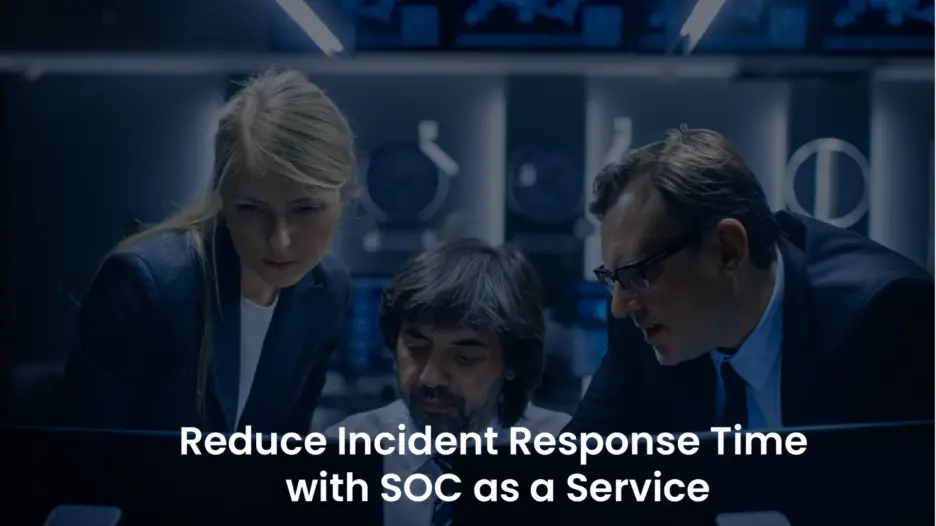
Before diving into the intricacies of SOC as a Service (SOCaaS), it is essential to first grasp the concept of a Security Operations Center (SOC), which encompasses its core functionalities, capabilities, and the indispensable role it plays in protecting an organization’s digital infrastructure. Understanding this context underlines the significance of SOCaaS.
This article provides an in-depth examination of how SOC as a Service effectively shortens incident response time. It discusses its critical importance, best practices, and essential metrics, including MTTD (Mean Time to Detect) and MTTR (Mean Time to Respond). It elaborates on how SOCs ensure continuous monitoring, employ automated triage, and orchestrate responses across cloud and endpoint environments. Additionally, it elucidates how incorporating SOCaaS with existing security frameworks enhances visibility and fortifies cybersecurity resilience. Readers will gain valuable insights into how a robust SOC strategy, regular drills, and comprehensive threat intelligence contribute to quicker containment, along with the benefits of leveraging managed SOC services to access seasoned analysts, advanced tools, and scalable processes without the necessity of developing these capabilities internally.
Effective Strategies for Reducing Incident Response Time with SOC as a Service
To significantly reduce incident response time through the utilization of SOC as a Service (SOCaaS), organizations must align technology, operational processes, and expert insights to quickly identify and contain potential threats before they escalate into major security incidents. A dependable managed SOC provider integrates continuous monitoring, advanced automation techniques, and a highly skilled security team to enhance every stage of the incident response lifecycle, ensuring that no threat goes unnoticed.
A Security Operations Center (SOC) functions as the central command hub for an organization’s cybersecurity architecture. When delivered as a managed service, SOCaaS amalgamates essential components such as threat detection, threat intelligence, and incident management into a unified framework, empowering organizations to respond to security incidents in real-time, thereby minimizing potential damage.
Key methods for effectively reducing response time include:
- Continuous Monitoring and Detection: By leveraging advanced security tools and SIEM (Security Information and Event Management) platforms, organizations can meticulously analyze logs and correlate security events across diverse endpoints, networks, and cloud services. This real-time monitoring provides a holistic view of emerging threats, significantly minimizing detection times and aiding in the prevention of potential breaches.
- Automation and Machine Learning: SOCaaS platforms harness the capabilities of machine learning to automate routine triage tasks, prioritize critical alerts, and initiate predefined containment strategies. This automation dramatically reduces the time that security analysts spend on manual investigations, allowing for swifter and more efficient responses to incidents, ultimately enhancing overall security effectiveness.
- Skilled SOC Team with Clearly Defined Roles: A managed response team comprises experienced SOC analysts, cybersecurity professionals, and incident response specialists who operate with clearly defined roles and responsibilities. This structured approach ensures that every alert receives immediate and appropriate attention, thereby enhancing the overall management of incidents and ensuring a more effective response to threats.
- Integrated Threat Intelligence and Proactive Hunting: Proactive threat hunting, supported by comprehensive global threat intelligence, enables early detection of suspicious activities, significantly reducing the risk of successful exploitation and enhancing incident response capabilities to mitigate potential threats.
- Unified Security Stack for Enhanced Coordination: SOCaaS consolidates various security operations, threat detection, and information security functions under a single provider. This integration improves coordination among security operations centers, leading to quicker response times and a reduced time to resolution for incidents, thereby fortifying the overall security posture of the organization.
Why is SOC as a Service Indispensable for Minimizing Incident Response Time?
Here are compelling reasons why SOCaaS is essential:
- Continuous Visibility Across Security Landscapes: SOC as a Service provides real-time visibility across endpoints, networks, and cloud infrastructures, facilitating the early detection of vulnerabilities and unusual behaviors before they escalate into significant security breaches, thereby enhancing overall security posture.
- 24/7 Monitoring and Swift Incident Response: Managed SOC operations operate around the clock, diligently analyzing security alerts and events. This continuous vigilance ensures rapid incident responses and swift containment of cyber threats, significantly enhancing the overall security posture of organizations.
- Access to Expert Security Teams: Partnering with a managed service provider grants organizations access to highly skilled security experts and incident response teams. These professionals can effectively assess, prioritize, and respond to incidents in a timely manner, alleviating the financial burden associated with maintaining an in-house SOC.
- Automation and Integrated Security Solutions: SOCaaS incorporates advanced security solutions, analytics, and automated response playbooks to streamline incident response strategies, significantly reducing delays caused by human intervention in threat analysis and remediation, thereby enhancing operational efficiency.
- Enhanced Threat Intelligence Capabilities: Managed SOC providers leverage global threat intelligence to proactively anticipate emerging risks within the evolving threat landscape, thereby bolstering an organization’s defenses against potential cyber threats.
- Improved Overall Security Posture: By integrating automation with expert analysts and scalable infrastructure, SOCaaS empowers organizations to maintain a resilient security posture, addressing contemporary security demands without overburdening internal resources.
- Strategic Alignment for Enhanced Focus on Core Business Functions: SOC as a Service allows organizations to concentrate on strategic security initiatives while the third-party provider manages daily monitoring, detection, and threat response activities, effectively reducing the mean time to detect and resolve incidents.
- Real-Time Management of Security Incidents for Maximum Efficiency: Integrated SOC monitoring and analytics provide a comprehensive overview of security events, enabling managed security services to identify, respond to, and recover from potential security incidents with remarkable efficiency, thereby minimizing impact.
What Proven Best Practices Can Enhance Incident Response Time with SOCaaS?
Here are the most effective best practices to consider:
- Establish a Comprehensive SOC Strategy: Develop clearly defined structured processes for detection, escalation, and remediation. A well-articulated SOC strategy ensures that each phase of the incident response process is executed efficiently across various teams, enhancing overall effectiveness and cohesion.
- Implement Continuous Security Monitoring for Maximum Effectiveness: Ensure 24/7 security monitoring across all networks, endpoints, and cloud environments. This proactive approach facilitates the early detection of anomalies, significantly reducing the time required to identify and contain potential threats before they escalate into major issues.
- Automate Incident Response Workflows for Greater Efficiency: Integrate automation within SOC solutions to expedite triage, analysis, and remediation processes. Automation diminishes the need for manual intervention while enhancing the overall quality and speed of response operations.
- Leverage Managed Cybersecurity Services for Scalability and Expertise: Collaborating with specialized cybersecurity service providers enables organizations to seamlessly scale their services while ensuring expert-led threat detection and mitigation without the operational complexities that come with maintaining an in-house SOC.
- Conduct Regular Threat Simulations to Ensure Preparedness: Execute simulated attacks, such as DDoS (Distributed Denial of Service) drills, to assess an organization’s security readiness. These simulations help identify operational gaps and refine the incident response process, enhancing overall resilience against actual attacks.
- Enhance Data Security and Visibility Across All Systems: SOCaaS platforms consolidate telemetry from multiple systems, offering unified visibility into network, application, and data security layers. This comprehensive perspective significantly shortens the time between detection and containment of threats, ensuring prompt action.
- Integrate SOC with Existing Security Tools for Greater Cohesion: Align current security tools and platforms within the managed SOC ecosystem to eliminate silos and improve overall security outcomes, fostering a more collaborative and efficient security environment.
- Adopt Solutions Compliant with Industry Standards for Enhanced Security: Collaborate with reputable vendors, such as Palo Alto Networks, to integrate standardized security solutions and frameworks that improve interoperability while reducing the frequency of false positives in threat detection.
- Continuously Measure and Optimize Incident Response Performance: Regularly assess key performance metrics, including mean time to detect (MTTD) and mean time to respond (MTTR), to identify opportunities for minimizing delays in response cycles and enhancing the maturity and effectiveness of SOC operations.
The Article Reduce Incident Response Time with SOC as a Service Was Found On https://limitsofstrategy.com

